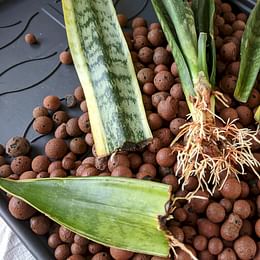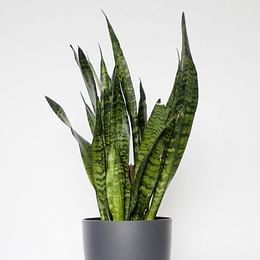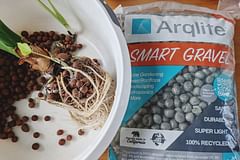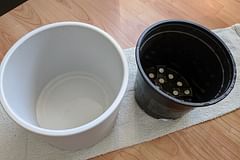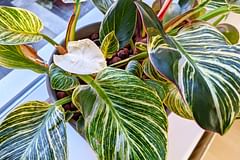How to grow Sansevierias in Leca
In this guide, we show you step by step how to prepare your pots, your plant, and your Leca. Then we'll show you how to plant it in Leca and how to water your plant from now on.
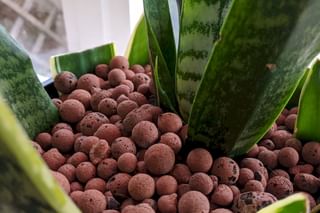
Together we'll go over how to grow your Sansevierias in Leca and then why you should do it. At the end of the post, you'll have all the knowledge you need to convert your Sansevierias from soil to Leca and help them thrive in their new environment. If you're looking for a general guide on how to take care of Sansevierias, it's best to read: How to care for Sansevierias.
Why should you grow Sansevierias in Leca?
We mentioned in the introduction that Sansevierias love a dry environment, so it seems a little strange that it can grow in an environment that revolves around a lot of water. You'd think that the Sansevieria will start to develop root rot and die, but this not the case. In fact, the Leca helps to properly hydrate the Sansevieria instead of exposing it to too much moisture. In our guide about "What is Leca and why is it useful for plants?", we mention that Leca helps to regulate the water distribution throughout the entire pot and helps to deliver as much or as little water to the Sansevieria as the plant needs.
When you use Leca with a Sansevieria, the plant will get all the moisture it needs from the clay balls, instead of the rather large amount of water at the bottom of the pot. When your Sansevieria needs more water, it'll simply grow its roots larger to search for more water. When they get to a certain size, they'll eventually reach the larger amount of water at the bottom of the pot. If it really needs this water to grow, it'll drink it. If it doesn't need as much water, it won't grow its roots as large.
You might be asking yourself: But doesn't soil do the exact same thing, but also help to feed the Sansevieria? You're absolutely right about that, but there is a subtle difference when using Leca. Let's get into that.
Is using Leca better than soil for Sansevierias?
We went over why you can grow Sansevierias in Leca and how it helps to properly water the plant. So is Leca better than soil when you're taking care of Sansevierias? The answer is: It depends. If you're looking for a more consistent growing medium for your plants, then yes, Leca is better. Leca is designed to regulate the water in the pot and this helps to keep the watering schedule for your plant very consistent. When you're watering your plants in soil, it will dry out and then be watered again in a cycle. With Leca, it's always watered to what the plant needs. This is what Leca is better at than soil.
Soil, on the other hand, is much better at feeding your Sansevieria. As Leca doesn't contain any nutrients by itself, this is something you need to add. Soil does contain nutrients and helps the plant to grow by watering and feeding it at the same time, without you having to think about adding fertilizer.
As you know, the Sansevieria loves to be in a dry environment, so when you use soil to grow your Sansevieria, you need to find the right soil: a very well-draining soil. This is not something you have to worry about when working with Leca. So Leca isn't better than soil, but it's more consistent.
In this guide, we show you step by step how to prepare your pots, your plant, and your Leca. Then we'll show you how to plant it in Leca and how to water your plant from now on.
Leca is a great medium for Sansevierias, because it helps to water your plants consistenly and carefully. But how do you actually grow them in Leca? Before we get started, there are two things that are very important when planting your Sansevieria in Leca:
- Make sure the Sansevieria roots are never below the water level
- Add a hydroponics fertilizer to the water
Sansevierias are very tough plants and Leca is very good at watering your plant, so you don't really have to think about anything that's related to watering your plant. The only thing you have to think about is how much sunlight to expose the Sansevieria to. But again, Sansevierias grow in low-light and direct sunlight, so it really is the ideal low maintenance situation.
We'll go over these steps to growing your Sansevierias in Leca:
- Clean the dirt off your Sansevieria
- Preparing the pots for use with Leca
- Preparing the Leca for first use
- Planting the Sansevieria in Leca
- Watering your Sansevieria
1. Clean the dirt off your Sansevieria
If your Sansevieria has grown in dirt up until now, it's important to clean it off first. When you're using Leca, you shouldn't have any dirt in the pot anymore. So pull your plant out of the pot and carefully clean all the dirt of the roots until it looks a little like the roots in the picture below. It doesn't have to be perfect, as long as the majority of the soil is off your plant.
2. Preparing the pots for use with Leca
Now that the roots of your Sansevieria are mostly clean, we can prepare your pots to be used with Leca. You can use pots that you've previously used with soil or get a new set of pots. Use a nursery pot with holes in the bottom and a waterproof pot and wash them both thoroughly with water and soap. The goal is to get rid of any dirt and dust. The picture below shows both the waterproof pot and the nursery pot completely clean.

3. Preparing the Leca for first use
Before we can plant the Sansevieria in Leca, we'll need to clean all the dust off the clay balls. If you're using Leca that you've already washed before, you can skip to the next step. If the Leca you're going to use for this project hasn't been used before, there will be a lot of dust on the clay balls. Cleaning them is very important. To do this, get a bucket and get enough clay balls to fill your pot up until about 2.5 cm (1 inch) from the top.
Now that one bucket is filled with the Leca, get a second bucket that's clean and empty. First, fill the bucket with the Leca with water and wash the clay balls thoroughly. When they're clean, move them into the second bucket, leaving the dirty water in the bucket you used to clean the clay balls. Throw the dirty water away and repeat the process until the leftover water is (almost) clean. This could be 4-5 cycles. Afterward, you have clean Leca and you're ready to plant the Sansevieria in your pots and Leca.
4. Planting the Sansevieria in Leca
When your Leca is clean, you can add a little base layer of it into your nursery pot. We're adding this base layer to make sure the Sansevieria roots never get below the water level in your pot. This baselayer serves as a false bottom.

Leca as a base layer in the nursery pot
This false bottom will keep the water in the bottom away from the roots. At the same time, it makes sure that the Leca at the bottom is able to soak up the water in the waterproof pot and regulate it throughout the pot. When you've got a nice base of Leca in the pot, you can add the Sansevierias and carefully fill up the pot with Leca until the pot is full and the Sansevierias a planted like below:
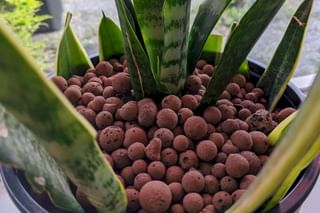
Sansevierias planted in Leca
As Sansevierias don't need a lot of water, they generally won't grow their roots as large as other plants. This allows you to add many plants in the same pot as in the picture above. It is up to you if this is something you want to do of course.
5. Watering your Sansevierias
Now the most important part of this process, watering your Sansevierias. Remember that false bottom we added in the nursery pot? That's going to be the maximum water level in our pot. Make sure you never add more water than that level, because that's when the roots of the plant will sit under the water level and this will cause root rot for Sansevierias. They're very sensitive to overwatering.

The way we're going to water the plant now is how you'll have to water your Sansevieria from now on. We'll water the Sansevieria by adding water to the waterproof pot and putting the nursery pot with the Leca and plant inside of it. The bottom part of the nursery pot will sit in the water and this will allow the Leca to start soaking up the water.
As Leca itself doesn't contain any nutrients, you'll need to add hydroponics fertilizer to the water. Make sure to follow the instructions on the label as different fertilizers can be used differently. Add the water with fertilizer in the waterproof pot like in the picture above.
Afterward, you can put the nursery pot with the holes in the bottom back in the waterproof pot. The Leca will now start to soak up the water and regulate it throughout the pot. The plant will start to get the moisture and fertilizer it needs from the Leca.
You have to repeat this last step again when the Leca has soaked up all the water it can reach. Don't be afraid to add more water if the Leca is still wet. It doesn't behave like soil would, so it'll only absorb the water if the plant has drank the water from the clay balls.
Conclusion
Growing Sansevierias isn't just a possibility, it's a really great way to water your plants consistently. When you're using Leca with your Sansevieria, you'll be much less likely to overwater your plant and you'll only have to worry about the light requirements for this plant. As Sansevierias can be exposed to low-light all the way up to direct sunlight, it's really the ideal low-maintenance plant.
Growing your plants in Leca is quite easy, as the most important thing you have to think about is that you should never let your plants sit in water. In this guide, we show you step by step how to prepare your pots, your plant, and your Leca. Then we'll show you how to plant it in Leca and how to water your plant from now on. It's quite a simple process to get used to and it'll help to make the maintenance on your Sansevieria even less than it was before.
Thank you for reading this post! I hope it helps you to keep your plants healthy and beautiful! If you're looking for more guides on specific plants, you can always request a plant guide to get a guide for the plant you have trouble with.
Test your plant care knowledge
Quiz completed!
Want to learn more? Sign up for my newsletter to receive free tips in your inbox!
Sign up now!

